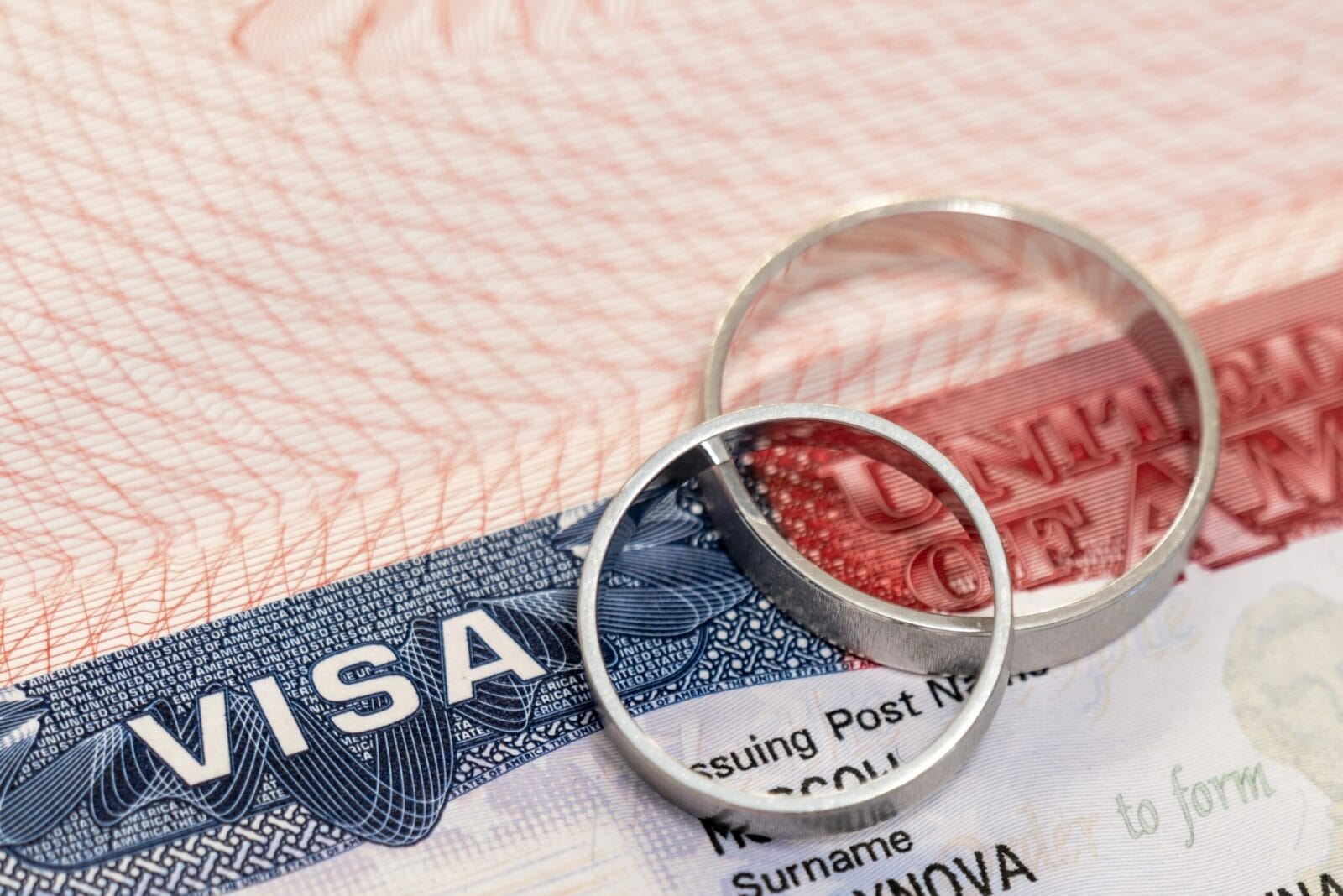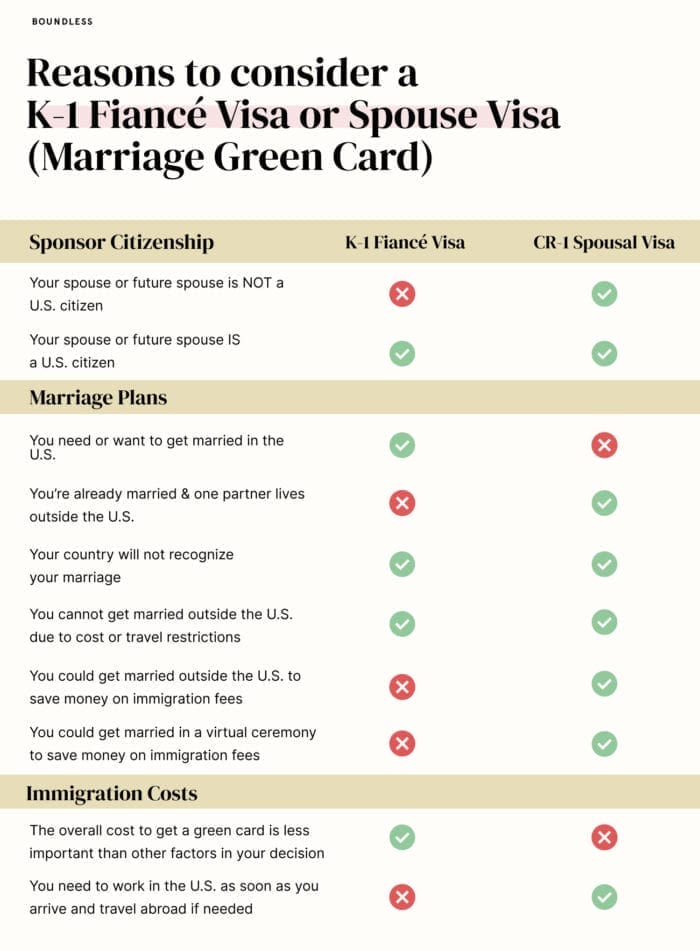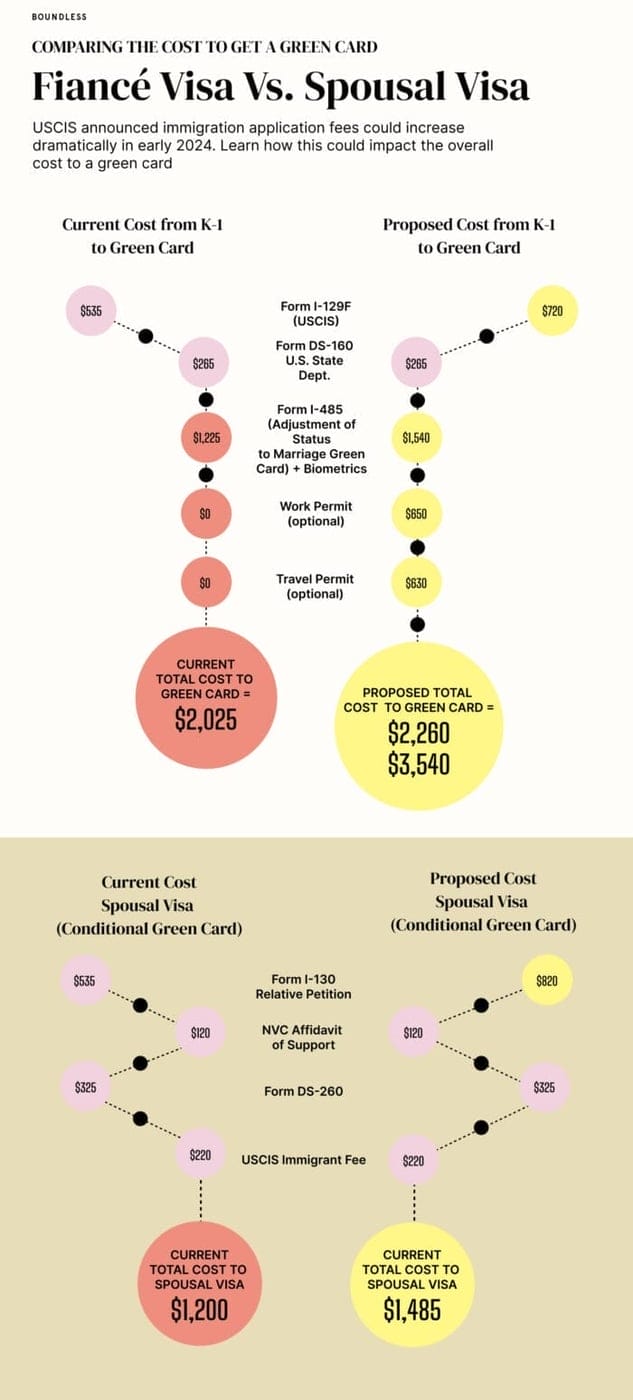How Is a Fiancé Visa Different from a Marriage Green Card?
Comparing the pros and cons of the K-1 vs. CR-1 visa

Congratulations on your engagement! If you’re visiting this page, it probably means you’re planning on building your life together in the U.S., you or your partner is a U.S. citizen, and one of you lives outside of the United States.
The Difference Between a Fiancé Visa and Spousal Visa
- A K-1 (fiancé) visa is a temporary visa, for couples who aren’t married to their U.S. citizen partner but plan to be.
- A spouse visa (also called a CR-1 visa) applies to couples who are married when one person is a U.S. citizen or green card holder living in the U.S. and the noncitizen spouse lives abroad.
Many engaged couples meet the requirements for either the K-1 fiancé visa or the CR-1 spousal visa (marriage green card). However, depending on your priorities, each of these visas allow couples to achieve different goals on different timelines, for different costs.
In this guide, we’ll explain the pros and cons of spouse visas and fiancé visas, so you can make an immigration plan based on your unique situation.
Boundless has helped more than 100,000 people with their immigration plans. We’ll partner with you to reach your goals from beginning to end. Get started today!
Not sure which immigration path to take? Boundless helps you find the right visa for you.
Reasons to Consider a K-1 Fiancé Visa or Marriage Green Card

Fiancé Visa Vs. CR-1 Spouse Visa Timelines
U.S. Citizenship and Immigration Services (USCIS) releases processing times each quarter for all forms, including Form I-129F (fiancé visa) and Form I-130 (spousal visa). According to the latest USCIS quarterly data, the wait time for a K-1 visa is 12.2 months, while a spousal visa currently takes 10.8 months. However, the factors listed in the chart in the section above can extend or speed up your timeline based on your specific circumstances.
Boundless tracks USCIS processing times data every month by application type. Below are the median timelines (as of September, 2023), according to our internal analysis.
| Fiance Visa (I-129F) | Spousal Visa (U.S. Citizen Petitioner I-130) |
|---|---|
| 6 months | 13.5–15 months |
To check the processing time for your specific form and field office, visit uscis.gov
We know that there are a lot of factors to consider when you’re making your immigration plans. If you’re on the fence, answer a few questions and we’ll point you in the right direction. Get started today!
Which Is More Affordable: Fiancé Visa Vs. CR-1 Spousal Visa?
Important:
In January 2023, the U.S. government proposed a sizable fee increase for most visa applications, which could go into effect as soon as early 2024. Applications received by the government before the fee increase goes into effect will not be impacted. Boundless is monitoring all fee increase updates closely, so be sure to check our USCIS fees guide for any additional information.
The chart below shows you a breakdown of costs to obtain a fiancé visa or spousal visa and in both cases, the costs to get a green card.

To save on your immigration costs, check out Boundless’ Essential application service. You’ll get step-by-step guidance from our experienced team and a complete visa application package, prepared to government standards. Get started today to learn more.
The Bottom Line
Because of the government’s proposed application fee increases and the visa processing backlog, if you’re engaged to a U.S. citizen and you’re able to be married outside the U.S. or online, the CR-1 spousal visa process could save you thousands of dollars. The immigration path you choose depends on a whole host of factors unique to your situation. By weighing up the pros and cons of each option, you and your partner can figure out the best way forward.

If you need help choosing the right path for you, Boundless can help. Answer a 5-minute questionnaire and we’ll guide you through your visa options. Get started today!
Frequently Asked Questions
Can I apply for a K-3 visa?
The K-3 visa allows the spouse of a U.S. citizen to enter the United States while they wait for their green card to be approved. However, the K-3 visa is rarely used. Since 2011, K-3 visas have made up less than 1% of K issuances. Generally, the CR-1 spousal visa offers the same benefits as the K-3 visa but is quicker and costs less. For more info, check out the Boundless guide about why the K-3 visa isn’t a viable option.
Can I apply for a K-1 visa if my partner is a green card holder?
No, only a U.S. citizen can sponsor a fiancé for a K-1 visa. However, a green card holder may sponsor their spouse for a marriage green card.
Is a K-1 visa more affordable than a marriage green card?
No, a K-1 visa costs significantly more than a marriage green card when including the mandatory application fee for the green card once the fiancé arrives in the U.S.
Which visa is best if I want to work in the U.S. as soon as I arrive and travel abroad if needed?
The CR-1 visa allows you to work as soon as you arrive in the U.S. and travel overseas if necessary. The K-1 visa, however, does not allow the foreign fiancé to work until they receive their marriage green card.
Who is eligible for a K-1 visa?
To be eligible for a K-1 visa, you must be engaged to a U.S. citizen and plan to marry within 90 days of arriving in the U.S. You must also prove that you have met in person at least once within the two years prior to applying for the visa.
How long do you have to be in a relationship for a K-1 visa?
There is no set time that you have to be in a relationship to qualify for a K-1 visa, but you must be able to prove that your relationship is genuine and not solely for immigration purposes.
Can CR1 visa holders work in the U.S.?
Yes, CR1 visa holders are permitted to work as soon as they arrive in the United States. They don’t need to apply for a separate work permit.
Can CR1 visa holders travel outside of the U.S.?
Yes, as a lawful permanent resident, CR1 visa holders are free to travel outside of the U.S. However, they shouldn’t leave the country for more than one year, as this may affect their eligibility for citizenship or reentry into the United States.
How long can you stay on a K-1 visa?
A K-1 visa allows you to stay in the U.S. for 90 days to get married and apply for a marriage green card via the adjustment of status process.
How much money do you need to sponsor a K-1 visa?
To sponsor a K-1 visa, the U.S. citizen must show an adjusted gross income that equals at least 100% of the Federal Poverty Guidelines on their most recent tax return. If they don’t meet this requirement, they can use a joint sponsor to meet the income threshold.
Which has a higher approval rate – the K-1 visa or the CR-1 spousal visa?
Overall, CR-1 visas tend to have a higher approval rate on average than K-1 visas. According to recent government data, K-1 visas have about a 25% denial rate, while CR1s have an average denial rate of around 8-9%. This difference in approval rates could be due to the fact that K-1 applicants may face additional challenges proving an authentic relationship since no legal relationship has been established yet through marriage. However, each case is unique and it is always at the discretion of USCIS to either approve or deny an application.
Why do K1 visas get denied?
K-1 visa denials can occur for various reasons such as failure to meet eligibility requirements, doubts about the authenticity of the relationship, insufficient evidence, and criminal or immigration violations.
What happens if my fiancé leaves me after marriage on a K-1 visa?
If your fiancé leaves you after marriage on a K-1 visa, you may be eligible for conditional permanent residency through a waiver. However, the process can be complicated, and you should consult with an immigration attorney for guidance.
What is the CR1 visa processing time for 2023?
The current processing time for the CR1 visa is 13.5–15 months if you’re married to a U.S. citizen and 29–40 months if you’re married to a green card holder.